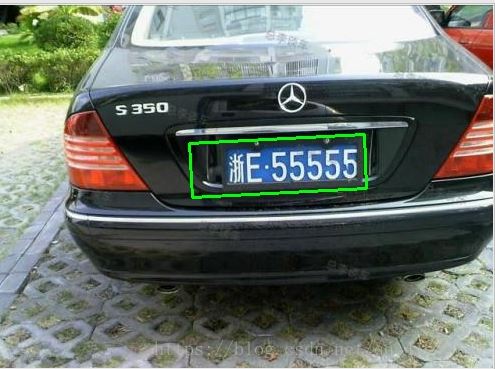溫馨提示×
您好,登錄后才能下訂單哦!
點擊 登錄注冊 即表示同意《億速云用戶服務條款》
您好,登錄后才能下訂單哦!
某天回家之時,聽到有個朋友說起他正在做一個車牌識別的項目
于是對其定位車牌的位置算法頗有興趣,今日有空得以研究,事實上車牌識別算是比較成熟的技術了,
這里我只是簡單實現。
我的思路為:
對圖片進行一些預處理,包括灰度化、高斯平滑、中值濾波、Sobel算子邊緣檢測等等。
利用OpenCV對預處理后的圖像進行輪廓查找,然后根據一些參數判斷該輪廓是否為車牌輪廓。
效果如下:
test1:


test2


實現代碼如下(對圖像預處理(濾波器等)的原理比較簡單,這里只是對一些函數進行調包):
import cv2
import numpy as np
# 形態學處理
def Process(img):
# 高斯平滑
gaussian = cv2.GaussianBlur(img, (3, 3), 0, 0, cv2.BORDER_DEFAULT)
# 中值濾波
median = cv2.medianBlur(gaussian, 5)
# Sobel算子
# 梯度方向: x
sobel = cv2.Sobel(median, cv2.CV_8U, 1, 0, ksize=3)
# 二值化
ret, binary = cv2.threshold(sobel, 170, 255, cv2.THRESH_BINARY)
# 核函數
element1 = cv2.getStructuringElement(cv2.MORPH_RECT, (9, 1))
element2 = cv2.getStructuringElement(cv2.MORPH_RECT, (9, 7))
# 膨脹
dilation = cv2.dilate(binary, element2, iterations=1)
# 腐蝕
erosion = cv2.erode(dilation, element1, iterations=1)
# 膨脹
dilation2 = cv2.dilate(erosion, element2, iterations=3)
return dilation2
def GetRegion(img):
regions = []
# 查找輪廓
_, contours, hierarchy = cv2.findContours(img, cv2.RETR_TREE, cv2.CHAIN_APPROX_SIMPLE)
for contour in contours:
area = cv2.contourArea(contour)
if (area < 2000):
continue
eps = 1e-3 * cv2.arcLength(contour, True)
approx = cv2.approxPolyDP(contour, eps, True)
rect = cv2.minAreaRect(contour)
box = cv2.boxPoints(rect)
box = np.int0(box)
height = abs(box[0][1] - box[2][1])
width = abs(box[0][0] - box[2][0])
ratio =float(width) / float(height)
if (ratio < 5 and ratio > 1.8):
regions.append(box)
return regions
def detect(img):
# 灰度化
gray = cv2.cvtColor(img, cv2.COLOR_BGR2GRAY)
prc = Process(gray)
regions = GetRegion(prc)
print('[INFO]:Detect %d license plates' % len(regions))
for box in regions:
cv2.drawContours(img, [box], 0, (0, 255, 0), 2)
cv2.imshow('Result', img)
#保存結果文件名
cv2.imwrite('result2.jpg', img)
cv2.waitKey(0)
cv2.destroyAllWindows()
if __name__ == '__main__':
#輸入的參數為圖片的路徑
img = cv2.imread('test2.jpg')
detect(img)
以上就是本文的全部內容,希望對大家的學習有所幫助,也希望大家多多支持億速云。
免責聲明:本站發布的內容(圖片、視頻和文字)以原創、轉載和分享為主,文章觀點不代表本網站立場,如果涉及侵權請聯系站長郵箱:is@yisu.com進行舉報,并提供相關證據,一經查實,將立刻刪除涉嫌侵權內容。